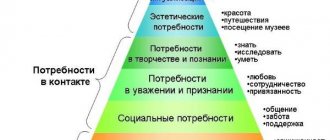Response plan
- The concept of temperament.
- Physiological theories of temperament
Humoral theories.
Galen and Hippocrates
- I. Kant and Lesgaft
- Kretschmer
- I.P. Pavlov
- K.G. Jung
The concept of temperament.
The term "temperament" was proposed in antiquity (Ancient Roman physician Galen, 2nd century AD). In translation - proportionality or proper relationship of parts. There is no clear definition of temperament. In general terms, temperament is understood as the dynamic characteristics of mental activity (Gippenreiter). Temperament (Nebylitsyn) is a characteristic of an individual from the dynamic characteristics of his mental activity, i.e. tempo, speed, rhythm, intensity, the mental processes and states that make up this activity. Temperament is a manifestation of physiological processes. It is studied more often in a diagnostic approach. There are 3 areas of manifestation of temperament: general activity, characteristics of the motor sphere and properties of emotionality.
General activity is determined by the intensity and volume of human interaction with the environment – physical and social. According to this parameter, a person can be inert, passive, calm, proactive, active, impetuous.
Manifestations of temperament in the motor sphere can be considered as particular expressions of general activity. These include pace, speed, rhythm and total number of movements.
When they talk about emotionality as a manifestation of temperament, they mean impressionability, sensitivity, impulsiveness, etc.
Currently, science has moved from studying types of temperament to studying its properties. The selection of properties is carried out on the basis of criteria, signs of temperament (V.M. Rusalov):
1) temperament expresses the formal-dynamic nature of behavior (it is not related to the content of the activity and determines the dynamics of the activity);
2) temperament is associated with biological substructures;
3) it is genetically determined, primary;
4) manifests itself early in childhood;
5) temperament is ontogenetically stable, that is, it is stable over certain periods of time. It is the result of development, not education;
6) temperament is cross-situational, that is, it manifests itself in a wide class of situations. It can be studied in various activities;
7) temperament manifests itself more clearly in the most difficult conditions for a person.
Temperament properties are inherent in all people, but with varying degrees of development. In modern psychology, 8 properties are distinguished (BC Merlin, B.M. Teplov, V.D. Nebylitsin): sensitivity, activity, reactivity, balance of activity and reactivity, rate of mental reactions, plasticity-rigidity, emotional excitability, extraversion-introversion.
Sensitivity is a general persistent feature of the nervous system and analyzers, which is expressed in general sensitivity (excitability of attention). It is determined by the strength of the external influence that causes a mental reaction (high sensitivity of the senses, as well as high sensitivity to ongoing events - empathy, anxiety, vulnerability. High sensitivity in melancholic people.
Activity – the degree of energetic influence on the outside world, overcoming obstacles (volitional component). High activity in choleric, sanguine and phlegmatic people and low in melancholic people.
Reactivity – impulsiveness, involuntary movements, reactions to external and internal influences. Manifests itself in the pace, strength and form of response to events. High reactivity in choleric and sanguine people and low in phlegmatic and melancholic people.
The balance of activity and reactivity is determined by what human activity is more dependent on: random, external (mood, random events, etc.) or internal (determination, beliefs, etc.) factors. Sanguine and phlegmatic people are balanced, while choleric and melancholic people are unbalanced.
The pace of mental reactions is the speed of mental processes (movements, speech, perception, etc.). The tempo is high for choleric and sanguine people, low for phlegmatic and melancholic people.
Plasticity-rigidity is the degree of a person’s adaptation to changing circumstances and activities.
Plasticity – flexibility, ease of adaptation to new conditions. Sanguine and choleric people are plastic.
Rigidity (lat. rigiditas - hardness) - inertia, inertia in adapting to new conditions, insensitivity to their changes. Phlegmatic and melancholic people are rigid.
Emotional excitability is the reaction time to emotionally significant and neutral stimuli. How weak influences are necessary for the emergence of emotions and the speed of their occurrence. Emotional excitability is high in melancholic and choleric people, low in sanguine and phlegmatic people.
Extraversion-introversion is the direction of mental activity outward or inward.
Extroversion is an individual personality trait, manifested in the predominant focus of consciousness on the world around us, in increased sociability, initiative, social adaptability, interest in other people, and openness of the inner world. Extroverts are choleric and sanguine.
Introversion is a person’s focus on himself, on his inner world, on his own actions, actions, experiences and thoughts. It manifests itself in unsociability, isolation, lack of interest in others and a tendency to in-depth introspection. Introversion is one of the basic personality traits. Introverts are phlegmatic and melancholic.
Galen and Hippocrates
Ancient Greek physician Hippocrates (5th century BC): health is determined by the correct ratio of 4 fluids (juices) in the body: blood is produced by the heart, mucus is produced by the brain, bile is produced by the liver, black bile is produced by the pancreas. The predominance of some kind of vital juice is a disease. Blood – “sangva”, mucus – “phlegm”, bile – “chole”, black bile – “melanchole” (4 types).
Galen (based on the work of Hippocrates) noted that liquids influence our behavior. If some liquid is in excess, a person behaves according to the organ that produces it (sanguine - excess blood - very energetic people; phlegmatic - excess mucus - slow reactions, tendency to think; choleric - bile - a quick-tempered, quarrelsome person; melancholic - excess black bile).
Thus, we can distinguish humoral concepts, theories of temperament (based on the work of Galen and Hippocrates). Humoral – relating to the liquid internal media of the body.
Physiological theory of I. P. Pavlov
Having determined the pattern of manifestation of individually typical differences, I. P. Pavlov proposed a hypothesis about the impossibility of explaining them only by different features of experimental situations.
Are you an expert in this subject area? We invite you to become the author of the Directory Working Conditions
To describe the physiological theory of I. P. Pavlov, it is necessary to refer to some properties of nervous processes.
As is known, the basis of human mental activity is made up of two processes: excitation (as the functional activity of nerve cells and centers of the cerebral cortex, which ensures the formation and maintenance of conditioned reflex connections that activate the mechanisms of memory, thinking, etc.) and inhibition ( as a process of attenuation of cortical connections, a decrease in the level of activity of nerve cells and centers, resulting in a weakening of memory, attention, etc.). These processes are characterized by such properties as the strength of excitation and inhibition, balance and mobility. The relationship between these properties and their combinations determine a specific type of nervous system - a natural, innate formation, which, as a rule, is not influenced by the social conditions of an individual’s life.
I. P. Pavlov proposed 4 types of nervous system (their identification in some way intersects with the typology of Hippocrates). Depending on the strength of nervous processes, the scientist proposed to consider strong and weak types of the nervous system. Further division is based on the balance of nervous processes (only for strong types), according to which balanced and unbalanced types are distinguished. In this case, the unbalanced type is characterized by the predominance of excitation over inhibition, and the balanced type, respectively, is the opposite. Finally, strong, balanced types are divided into mobile and inert types (the basis for the division is the mobility of nervous processes). All types of the nervous system are shown schematically in Fig. 1.
Finished works on a similar topic
Course work Physiological concepts of temperament 450 ₽ Essay Physiological concepts of temperament 270 ₽ Examination Physiological concepts of temperament 220 ₽
Receive completed work or specialist advice on your educational project Find out the cost
Rice. 1. Types of the nervous system (according to I. P. Pavlov)
Thus, I. P. Pavlov identifies the following 4 types of the human nervous system (at the same time, the researcher draws a parallel with the classical types of temperament):
- The nervous system of the first type corresponds to a strong, balanced, mobile – sanguine – temperament. A person of this type is characterized by optimally balanced volitional and communication properties, speed, and ease of adaptation to changed living conditions. He is active, sociable, does not experience difficulties in establishing contacts with new people, therefore he has a wide circle of acquaintances, despite the fact that he is not characterized by constancy in communication and attachments. In the professional sphere, he is characterized as a very productive figure.
- The nervous system of the second type corresponds to a strong, unbalanced – choleric – temperament. This is a person in whom the processes of higher nervous activity are associated with the predominance of excitation over inhibition. Such a person is distinguished by a high level of vital energy, but he often lacks self-control and restraint. Lack of balance in the nervous system is manifested in cyclical changes in activity and vigor. A person of this type easily gets involved in a new type of activity, but does not always calculate his own strength. Has difficulty coping with activities that require smooth movements or a calm, slow pace.
- The nervous system of the third type is distinguished by a strong, balanced, inert – phlegmatic – temperament. Such a person is characterized by high performance, internal stability, as well as the inability to abandon developed behavioral stereotypes and habits that shape his entire day. Has difficulty with being included in new life circumstances. The emotional sphere is inert - emotions and feelings manifest themselves dimly, sometimes with a delay. However, this type of people is not susceptible to the painful effects of strong and prolonged irritants and resists them well.
- Nervous system of the fourth type - weak - melancholic temperament. A person of this type is characterized by poor performance, the need for long periods of rest, and strong emotional reactions even to minor influences. He has difficulty withstanding prolonged and sudden stress, gets lost in exams, and cannot speak in public. As a rule, such people often cry and have increased suggestibility. But at the same time, people with a weak nervous system are very sensual, easily navigate the world of nuances and subtle transitions, and have pronounced creative or intellectual abilities.
In the process of researching and describing the types of the nervous system, Pavlov realized that these were not real portraits, since it is rare to find a person who has all the signs of a particular type of temperament. But at the same time, Pavlov’s concept, which established connections between temperament and the type of nervous system, became a serious step towards the development of a typological system of personality temperament.
Literature
- Hippocrates. "Selected Books". M., Biomedgiz, 1936.
- Hippocrates. "Essays". M.-L., Medgiz, 1944, vol.II-III.
- Gusev I.S. Hippocrates. Donetsk: Donetsk region. 1995. ISBN 5-86938-095-2
- Volsky S.F. About Hippocrates and his teachings. From the lane in Russian language three of his most important and authentic books. St. Petersburg, 1840.
- Kozlov A. M., Kosarev I. I. Hippocrates and moral and ethical problems of medicine: Textbook. M.: I MMI. 1983.
- Jacques J. Hippocrates. / Per. from fr. (Series “Trace in History”). Rostov-on-Don: Phoenix. 1997.
- Petrov B.D. "Hippocrates". Clinical medicine, 1990, No. 9, p. 116-119.
Professional activity
In modern psychological science, there is a firm belief that a person’s type of temperament is innate and generally characterizes the characteristics of the dynamics of nervous processes. But what specific properties of its innate organization it depends on is currently not yet known.
Since the characteristics of temperament determine the dynamics of mental processes, one could assume that temperament determines the success of a person’s activities. However, it has been established that if the activity takes place under conditions that can be defined as normal, then there is no relationship between the level of achievement, that is, the final result of the actions, and the characteristics of temperament. Regardless of the degree of mobility or reactivity of an individual in a normal, non-stressful situation, the results of the activity as a whole will be the same, since the level of achievement will depend mainly on other factors, and not on the characteristics of temperament.
At the same time, studies establishing this pattern show that depending on the characteristics of temperament, the way of carrying out the activity itself changes. B. M. Teplov also drew attention to the fact that, depending on the characteristics of their temperament, people differ not in the final result of their actions, but in the way they achieve results. Developing this idea, domestic psychologists conducted a number of studies to establish the relationship between the method of performing actions and the characteristics of temperament. These studies examined individual performance style as a path to achieving results or a way of solving a certain task, determined mainly by the type of nervous system. The results of studies by the vast majority of authors, regardless of the characteristics of the groups studied and the experimental situations in which the typical way of performing actions for these individuals was studied, show that it is the type of nervous activity, and above all the strength and mobility of nervous processes, that has a significant impact on the formation of a certain style activities.
For example,
persons with a predominance of arousal at the first stage show increased activity, but at the same time make many mistakes. Then they develop their own style of activity, and the number of errors decreases. On the other hand, people with a predominance of inhibition at first are, as a rule, inactive, their activities are unproductive, but then they form their own way of performing activities, and the productivity of their work increases sharply.
In conclusion, it should be noted again that there are no good or bad temperament types. The special mobility (reactivity) of a sanguine person can bring an additional effect if the work requires a change in objects of communication, type of occupation, or frequent transition from one rhythm of life to another. People with weak nervous systems –
melancholic people
are
more motivated to perform simpler actions than others.
Therefore, they are less tired and irritated from their repetition. Moreover, since people with a weak nervous system are more sensitive to external influences, that is, they react to them faster, then, as studies by E. P. Ilyin show, the majority of high-class sprinters have precisely this type of nervous system. At the same time, athletes whose activities take place against the background of excessive emotional stress, for example
weightlifters, will for the most part have a strong nervous system.
Therefore, it is not only impossible, but also pointless to strive to change temperament. It seems more appropriate to take into account the temperament properties of a particular individual when organizing activities.
"Hippocratic collection"
The Hippocratic Corpus that has come down to us (“Hippocratic Collection”) contains approx. 70 separate works, although it is clear that some of them are parts of once united works. In addition, there is a certain overlap of some works with others and repetitions. The collection contains both Hippocrates' own works and works by other authors written at different times. It has been suggested that the corpus represents the remains of a medical library rather than the works of authors belonging to the same school. Some of the writings demonstrate advanced scientific thought and skill in clinical observation and are therefore considered more “authentic” than others. But even on this issue there is no generally accepted opinion: there are researchers who generally doubt the existence of works belonging to Hippocrates himself.
Page from the Hippocratic collection
Hippocrates established the stages of development of diseases, laid the foundations of ancient surgery, developed methods for using bandages, treating fractures and dislocations, and introduced the concepts of anamnesis, prognosis, and etiology into medicine; divided people by temperament (sanguine, choleric, phlegmatic, melancholic). All medicine, in the views of Hippocrates, has a psychosomatic frame. This is medicine of both body and soul. Medicine is based on the harmony of man with nature and the cosmos.
Is it possible to change it
How to find a husband - where you can meet a worthy man for a family
The type of temperament is laid down in the child in the womb; on the other hand, each person, depending on the current situation, manifests himself differently. For example, under extreme conditions, even the most ardent melancholic person can become choleric for a while.
There is an opinion among people that temperament cannot be changed in any way. It is erroneous, since even the most ordinary person can change their temperament for a short time; trained people can, in principle, choose it for themselves. In the process of education and training, most people can easily work out all types of temperaments for themselves.
Correlation between types of GNI and properties of temperaments
To consider the types of Higher Nervous Activity (HNA) and their connection with temperaments, the following properties were selected:
- force;
- equilibrium;
- mobility.
Here we can refer to Pavlov's theory discussed above.
The properties were correlated as follows: sanguine, phlegmatic and choleric are representatives of a strong nervous system, while balance is characteristic only of phlegmatic and sanguine people. The mobility of the system predominates in sanguine people. A melancholic person is classified as having a weak GNI.
List of recommended literature
Batarshev A.V.
Temperament and properties of higher nervous activity [Text] / A.V. Batarshev. – M.: TC Sfera, 2002. – 88 p.
Mental states [Text]: reader / comp. L.V. Kulikov. – St. Petersburg: Peter, 2000. – 506 p.
Rusalov V.M.
Temperament [Text]: reference. management / V.M. Rusalov. – M.: Infra-M, 1999. – 687 p.
Examples of similar educational works
Analytical professional profile of the activities of a psychologist in the process of professional selection of candidates...
... activities. The psychological system of activity is a set of mental properties and qualities of the subject of labor, organized to perform the functions of a specific activity. The development of the psychological system of activity occurs both in the process...
Motivation of human activity 2
...society of behavior. Behavior is a socially significant part of the system of human activity. The formation of human behavior occurs through ways to satisfy human needs. In our work we intend to consider motivation...
Human cognitive activity 2
... The results can be used for future research. The object of the work is the system “Methodology and logic of human cognitive activity.” The subject of the study is the current relationship of the philosophical world to this problem. Target …
Human labor activity
... 2 - Characteristics of activity Main forms of activity: game; educational activities; work activity; leisure. The highest form of activity is labor. Labor is a fundamental form of human activity, in the process of which all...
Temperament should be understood as individually unique properties of the psyche that determine...
... chole - black bile). Characteristics of temperament types: Sanguine is a strong type of nervous system with a balanced ratio of excitation and inhibition processes. Such people have a mood “written all over their faces.” They give …
Development of Hippocrates' ideas
The teaching had a great influence on the ideas of physicians and psychologists of subsequent eras. The main principles of modern medical morality are based on the “Hippocratic Oath” developed in antiquity.
The development of Hippocrates' ideas was undertaken by many doctors, physiologists and psychologists. The most interesting studies are represented by the works of E. Kretschmer, W. Sheldon, G. Eysenck, I.P. Pavlova, Y. Strelyau, L.N. Sobchik, V.P. Rusalov, V.D. Nebylitsyn, T.F. Bazylevich et al.
Research by E. Kretschmer and W. Sheldon. Presentation.
Research by G. Eysenck, I.P. Pavlova, Y. Strelyau.
Psychological characteristics of temperaments
Let's consider the features of well-known types of human temperaments:
Who is a sanguine person?
Sanguine people are sociable. They quickly find new friends and are easy to get in touch with. One can envy the optimism of such people; they are interested in new experiences and are open-minded. Sanguine people quickly switch from one job to another, but they love variety. The feelings of such people also change quickly, they light up and cool down, flare up and fade away. Grief or joy, sympathy or disgust - all emotions are short-term in nature; sanguine people are not capable of deep feelings. Brightness and richness of information make them attractive interlocutors, but with deeper contact it becomes clear that knowledge is superficial and feelings are changeable. Sanguine people are extroverts.
Who is a phlegmatic person?
Phlegmatic people have a calm, balanced psyche. They are leisurely. Having started something, a person of this temperament will complete the work to the end. They are distinguished by persistence to the point of being boring. The facial expressions and speech of a phlegmatic person are calm. He is reluctant to adapt to new conditions and has a hard time getting along with people. When communicating, such a person is laconic, calm and balanced. The affection of a phlegmatic person is deep and stable; he is not easily angered. The reliability and efficiency of a phlegmatic person makes him a good performer, a faithful comrade and a worthy spouse. Sometimes such people may lose interest in work or the world around them and withdraw into themselves. Phlegmatic people are often introverts.
Who is a choleric person?
Cholerics are energetic, active and quick-tempered. They are like a burning match: they quickly ignite and go out. The choleric person is in a hurry to live, his reactions and gestures are swift, but problems arise with inhibition. Cholerics are not restrained in words and actions, and often make enemies for themselves because of this. In relationships they are impetuous and hot-tempered. They are energetic and quick at work, light up, overcome obstacles, but results are not always achieved, since the fuse is not enough for long-term calm actions. The monotony of activity drains energy, causing incontinence and irritation. Choleric people are usually extroverts.
Who is a melancholic person?
The mental processes of a melancholic person are leisurely. Irritants cause him to react slowly. Stress can lead to complete withdrawal from activities. Melancholic people do not take initiative and are not interested in external events. A person of this type gets tired easily, his tone is constantly low, “he doesn’t have enough strength for anything.” It is difficult for him to concentrate on action, he speaks in a quiet voice, his facial expressions are inexpressive. Melancholic people are anxious, unsure of themselves, and fearful. New people or circumstances make them afraid. The feelings of a melancholic person are deep and emotional, but he does not show them outwardly. In everyday situations, it works well if the activity is not associated with stress. Melancholic people are deep introverts.









